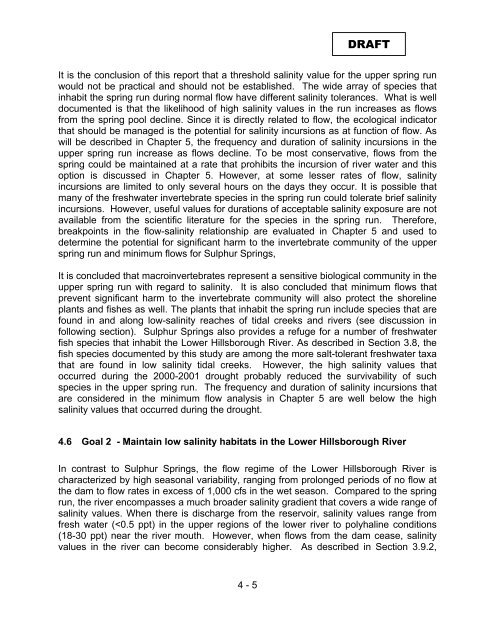The Determination of Minimum Flows for Sulphur Springs, Tampa
The Determination of Minimum Flows for Sulphur Springs, Tampa
The Determination of Minimum Flows for Sulphur Springs, Tampa
Create successful ePaper yourself
Turn your PDF publications into a flip-book with our unique Google optimized e-Paper software.
DRAFT<br />
It is the conclusion <strong>of</strong> this report that a threshold salinity value <strong>for</strong> the upper spring run<br />
would not be practical and should not be established. <strong>The</strong> wide array <strong>of</strong> species that<br />
inhabit the spring run during normal flow have different salinity tolerances. What is well<br />
documented is that the likelihood <strong>of</strong> high salinity values in the run increases as flows<br />
from the spring pool decline. Since it is directly related to flow, the ecological indicator<br />
that should be managed is the potential <strong>for</strong> salinity incursions as at function <strong>of</strong> flow. As<br />
will be described in Chapter 5, the frequency and duration <strong>of</strong> salinity incursions in the<br />
upper spring run increase as flows decline. To be most conservative, flows from the<br />
spring could be maintained at a rate that prohibits the incursion <strong>of</strong> river water and this<br />
option is discussed in Chapter 5. However, at some lesser rates <strong>of</strong> flow, salinity<br />
incursions are limited to only several hours on the days they occur. It is possible that<br />
many <strong>of</strong> the freshwater invertebrate species in the spring run could tolerate brief salinity<br />
incursions. However, useful values <strong>for</strong> durations <strong>of</strong> acceptable salinity exposure are not<br />
available from the scientific literature <strong>for</strong> the species in the spring run. <strong>The</strong>re<strong>for</strong>e,<br />
breakpoints in the flow-salinity relationship are evaluated in Chapter 5 and used to<br />
determine the potential <strong>for</strong> significant harm to the invertebrate community <strong>of</strong> the upper<br />
spring run and minimum flows <strong>for</strong> <strong>Sulphur</strong> <strong>Springs</strong>,<br />
It is concluded that macroinvertebrates represent a sensitive biological community in the<br />
upper spring run with regard to salinity. It is also concluded that minimum flows that<br />
prevent significant harm to the invertebrate community will also protect the shoreline<br />
plants and fishes as well. <strong>The</strong> plants that inhabit the spring run include species that are<br />
found in and along low-salinity reaches <strong>of</strong> tidal creeks and rivers (see discussion in<br />
following section). <strong>Sulphur</strong> <strong>Springs</strong> also provides a refuge <strong>for</strong> a number <strong>of</strong> freshwater<br />
fish species that inhabit the Lower Hillsborough River. As described in Section 3.8, the<br />
fish species documented by this study are among the more salt-tolerant freshwater taxa<br />
that are found in low salinity tidal creeks. However, the high salinity values that<br />
occurred during the 2000-2001 drought probably reduced the survivability <strong>of</strong> such<br />
species in the upper spring run. <strong>The</strong> frequency and duration <strong>of</strong> salinity incursions that<br />
are considered in the minimum flow analysis in Chapter 5 are well below the high<br />
salinity values that occurred during the drought.<br />
4.6 Goal 2 - Maintain low salinity habitats in the Lower Hillsborough River<br />
In contrast to <strong>Sulphur</strong> <strong>Springs</strong>, the flow regime <strong>of</strong> the Lower Hillsborough River is<br />
characterized by high seasonal variability, ranging from prolonged periods <strong>of</strong> no flow at<br />
the dam to flow rates in excess <strong>of</strong> 1,000 cfs in the wet season. Compared to the spring<br />
run, the river encompasses a much broader salinity gradient that covers a wide range <strong>of</strong><br />
salinity values. When there is discharge from the reservoir, salinity values range from<br />
fresh water (

















